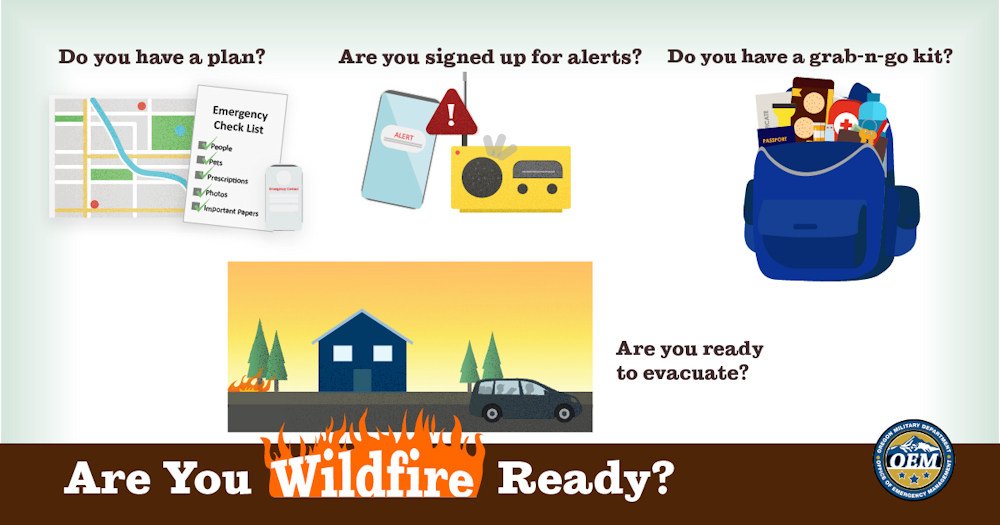Wildfire Awareness Month: Have a plan, build a kit, be ready to evacuate

SALEM, Ore. (KTVZ) -- As Oregon continues to recover from the historic and destructive 2020 wildfire season, abnormally dry conditions and pre-season fires on the landscape are causing concern for the 2021 wildfire season. Now is the time for Oregonians to prepare themselves, their families and their homes for wildfire.
May is Wildfire Awareness Month, and the Oregon Office of Emergency Management (OEM) and partners are engaged in a month-long campaign to encourage, empower and inform Oregonians to help prevent and prepare for wildfire.
Being prepared starts with an emergency plan. As simple as a list of important contacts and knowing where to go in case of evacuation, emergency plans are more effective when they are practiced with household members.
Building an emergency kit or go bag that can be grabbed in a hurry is another way to prepare for disaster. “These are challenging times, and as we continue to rebuild after last year’s wildfires, it is more important than ever to prepare ourselves, our families and our communities against the threat of wildfire,” said OEM Director Andrew Phelps. “Gathering important documents to add to your go bag, talking about your emergency plan with your family, and signing up for local alerts are all small steps you can take now. These actions can make all the difference when disaster strikes and in the days that follow.”
It is also important to be familiar with “Be Ready, Be Set, Go!” – a statewide evacuation system used to notify communities facing a threat, or potential threat, to lives and property. Oregonians can sign up for emergency alerts in their county to receive real-time evacuation notifications.
The “Be Ready, Be Set, Go!” evacuation levels are as follows:
• Level 1 Evacuation means “BE READY” for potential evacuation. Community members should be aware of the danger that exists in their area and monitor emergency services websites and local media outlets for information. This is the time for preparation and precautionary movement of persons with special needs, and in some cases, pets and livestock.
• Level 2 Evacuation means “BE SET” to evacuate. Oregonians should be ready to leave at a moment’s notice, as this level indicates there is significant danger to the area. The public should be prepared to voluntarily relocate to a shelter or with family or friends outside of the affected area. They may have time to gather necessary items but doing so is at their own risk.
• Level 3 Evacuation means “GO.” Leave immediately! Danger to the area is current or imminent. If a person chooses to ignore this advisement, emergency services may not be available to offer further assistance. People should not stop to gather any belongings or make efforts to protect their home or shelter.
“Emergencies happen – Oregonians have certainly seen more than our fair share of them the past few years. But even as we continue to rise to the challenge, it’s critical that we prepare ourselves and our families for the next bad day. Prevention is key but being ready for wildfires we can’t prevent is a way we can reduce risk and help one another to be disaster survivors rather than disaster victims,” Phelps added.
OEM has an array of preparedness materials to help people plan for disasters, which are available through local county emergency management offices. One of these is “My Pocket Plan,” a mini booklet that provides a convenient place to store personal emergency information like work and school phone numbers, insurance information, medical contacts and prescription details. OEM’s My Pocket Plan also contains a list of basic emergency kit items and links to other disaster preparedness resources.
For information on what to include in an emergency evacuation bag, visit Redcross.org/get-help/how-to-prepare-for-emergencies/survival-kit-supplies.html.
OEM encourages people to prepare for all emergencies and be prepared to be on their own for a minimum of two weeks. For more information on how to be 2 Weeks Ready and other personal preparedness resources, visit Oregon.gov/oem/2WeeksReady.
For information on how to prevent and prepare for wildfire visit Keeporegongreen.org.
To learn more about how to receive local alerts in your area, contact your county emergency manager.